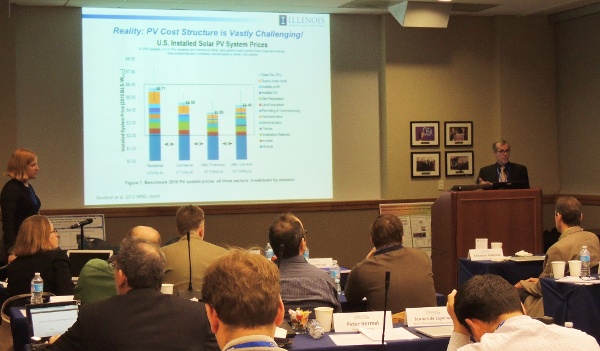Hot making cold with optics for energy
Hot making cold with optics for energy
Jonathan Tong
We began with a keynote talk by Shanhui Fan. He introduced the concept of radiative cooling to the universe through the atmospheric transparency window and showed that with his photonic nanostructure design, it is possible to experimentally achieve a cooling power of 40 W/m^2 even when under direct illumination from the sun. This can be used to cool buildings to reduce the energy cost of AC systems and to cool solar cells to reduce the saturation current. Shanhui Fan also showed that Kirchoff’s law can in fact be broken by creating a material that does not abide by time reversal symmetry. This can be easily achieved using well known magneto-optical effects. As a result, he showed it is possible for a material to exhibit a different absorptivity and emissivity along the same direction. It should be stressed that this does not violate the second law of thermodynamics!
Since space is a great heat sink (T ~ 3K), it was also proposed by Steven Bynes that it may be possible to harvest energy from the ambient environment using space to form a heat engine. He suggested that it may be possible to create a rectifying antenna known as a rectenna that operates in the infrared wavelength range.
There were also several talks on thermophotovoltaic (TPV) systems which involves the conversion of a heat source such as the sun or the combustion of fuel to thermal radiation that emits right above the band gap of a PV cell. Marin Soljacic showed that it is possible to create a film that reflects light across the entire visible spectrum except at one angle in which it is transparent. This could be used in TPV systems to recycle photons that are radiative emitted thus improving overall performance. One central challenge in TPV systems is the ability for components, such as the absorber/emitter, to sustain high temperatures. David Woolf showed a design for a high temperature selective emitter using a Pt metasurface with an Al2O3 buffer layer that could in principle remain stable at temperatures greater than 1300K. Peter Bermel presented designs using a molybdenum, samarium-dope glass, and tungsten photonic crystal emitters that are predicted to lead to high efficiency TPV systems.
We also heard a new approach by Carmel Rotschild towards solar thermal energy that makes use of endothermic photoluminescence which theoretically can lead to energy conversion efficiencies of 70%. The idea is for a low band gap PV cell to absorb incoming sunlight and rather than emit thermally, as is the case in TPV systems, uses low energy photons to thermally enhance photoluminescence to emit high energy photons to a larger band gap PV cell. This does not require high temperatures to achieve high efficiency.
To conclude, it was an incredible two day event that not only led to new insight on existing technologies and new approaches towards optical energy conversion, but also provided a platform for all attendees to discuss and hopefully collaborate on future endeavors. We would like to give a big thanks to the participants for sharing their insight in this field, the OSA staff for organizing the logistics that made this event possible, the sponsors including Massachusetts Institute of Technology Lincoln Laboratory, ISI Physical Sciences Inc., and the Department of Energy Advanced Research Program Agency – Energy (ARPA-E), and last but not least the hosts for putting together this Incubator.

Ralph Nuzzo, University of Illinois

Susanna Thon, Johns Hopkins University
